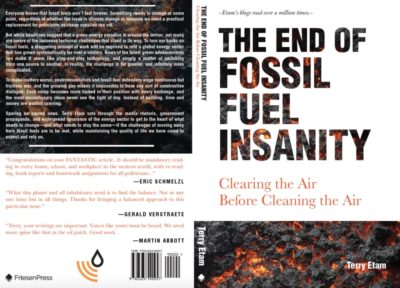I walked past a truck in a parking lot the other day and I figured out what’s wrong with everybody. It was a good-looking new semi-small one, and, walking with my head down, watching for ice and muttering as usual, I almost walked into the side of it. There, staring me in the face, was a huge decal on the side that said: “Tremor.”

It was a Ford Ranger Tremor XLT. Hmm. Maybe it was just a weird day but for some reason the absurd names struck me literally. In the real world, I know what a ranger is, and I know what a tremor is…what would possess someone to designate a truck so stupidly? What is the connection, or even the common thread, and what does it mean to take two rugged non sequiturs and XLT them? It could have been worse; the Tremor can be had on the highest level trim giving us the Ford Ranger Tremor Lariat, the nomenclature equivalent of wearing a butchers apron, a mini skirt, a football helmet, boxing gloves and stilettos simultaneously.
Of course, it’s gibberish, marketing gibberish. We’re all desensitized to it. Maybe it works subconsciously but in order to take the vehicle seriously we have to suspend critical thinking.
That is a dangerous habit. The truck’s meaningless yet bellowing flanks drove home how desensitized we have become to gobbledygook. The goalposts move; what would have been insane at one point just creeps up until it’s [yawn]. Imagine if Henry Ford had called the Model T the Model Ranger Tremor Lariat. Everyone would have gone back to horses.
The desensitization is harmless in the world of consumer crap, but dangerous in the world where thinking matters. When people trust news sources, they simply accept what they are told. Often links are provided, and people ignore them for whatever reason, never following up on the veracity or relevance. Sixty-two percent* of North Americans do not follow a link to see if the “evidence” is relevant.
The media knows how low their credibility is, so they have a new strategy to win us back – the rapidly spreading fungi known as ‘fact checkers’. They’re everywhere. It’s supposed to be a mark of credibility now, that not only is the site in question beyond reproach, but it is also capable of judging for you what is and is not “fact”. (Facebook murmured in court that their fact checks are just “opinion.”)
One of the dumbfounding things about the energy transition is that those who feel the need to will it into existence are willing to ignore realities on the grounds that “we need to do this, so it will happen.” If they were limiting these normative hydraulics to their own saddened lives, such as if they were trying to shed a few pounds or eradicate some person habit that vexes them to fury, then hey, go nuts – feel free to make such declarations at will.
But no, they treat the real world as thought it was a weight loss program. Take the considerable challenge of mineral/metal availability for the net-zero 2050 energy transition that ‘must happen’. Some groups have decided to actually try to do the math, to calculate how much more we’ll need, mineral-wise (all skirt the issue of how we’ll get them – permitting, protesters, growing regulations, endangered species, etc. – because no one has a bead on that at all).
The International Energy Agency, an organization that has shed much credibility on the altar of political correctness, last year issued a report on just how short the world is of critical minerals (from the report: “a concerted effort to reach the goals of the Paris Agreement (climate stabilization at “well below 2°C global temperature rise”) would mean a quadrupling of mineral requirements for clean energy technologies by 2040. An even faster transition, to hit net-zero globally by 2050, would require six times more mineral inputs in 2040 than today.”). [Emphasis theirs]
Another more credible group came to an even starker conclusion – the Geological Survey of Finland concluded that there simply aren’t enough reserves of critical minerals and metals in the world to enable the transition that is deemed to be inevitable.
Despite the fact that such research is mostly ignored in the media, groups appeared out of the woodwork to discredit such analyses, just in case anyone started taking it too seriously. It is not permissible to question the energy transition; wheels must be put in motion to staunch this info flow. Watch the machine at work.
First, a handful of activists wrote a ‘peer-reviewed paper’ that was published in the publication Joule entitled “Future demand for electricity generation materials under different climate mitigation scenarios.”
The authors’ (led by energy transitionists Seaver Wang and Zeke Hausfather, neither of whom have any connection to mining, geology, or the existing energy system) concluded: there are plenty of minerals in global reserves. How did they figure that, when geologists concluded resoundingly the opposite? More on that in a second.
Their work was picked up by, of all places, the MIT Technology Review which cited the report to do some ‘myth-busting’ – and wrote an article entitled “Busting three myths about materials and renewable energy.”
From the MIT article: “focus[ing] on the two industries with the highest emissions today: electricity generation and transportation…in order to cut emissions in these sectors, we need to build a lot of new infrastructure, especially new ways of generating electricity and batteries that can store it…But in every case, the planet has plenty of reserves of the materials we need.” [Emphasis theirs]
Hmm. What gives? Are the geologists wrong, or MIT? A battle of the titans!
I dove into both reports to analyze the discrepancy. It didn’t take long.
The Finnish geologists looked at all the components required for net-zero 2050, and did the math – to build out everything required, there simply isn’t enough in global reserves.
The IEA critical minerals assessment came to a similar conclusion, but copped out by saying, in effect, sure, there will be enough minerals, so long as we quadruple mining requirements by 2040. They then quietly mention that historically it has taken 18 years for the average new mine to come on line, and don’t mention at all that new ones get ever harder. In reality their conclusion was the same as the Finnish geologists.
So where did the discrepancy originate? Through some clever sleight of hand.
The Joule study’s authors – Wang, Hausfather, et al – took a nifty shortcut. They assessed how much minerals and metals would be required to build the electrical generation infrastructure of a sub 1.5 degree increase – that is, wind turbines, solar panels, hydro power, etc. – and nothing else.
They excluded transmission lines. They excluded all the batteries that would go into EVs. They excluded large scale batteries that are deemed necessary to go alongside all that wind/solar. They excluded everything except the manufacture of the renewable pieces themselves, largely wind and solar equipment. They throw in comments like “As many materials, such as rare earth metals, are employed across numerous technologies from electric vehicles to drones to aircraft, increasing demand from the power sector over coming decades could strain economy-wide supply chains…”
Statements like that sweep an awful lot under the rug. It is ironic that these sweeping generalizations never come with a footnote, though they are the often the most relevant pieces of the whole document. It is not acceptable to gloss over the gigantic hurdles while meticulously referencing the minutiae, particularly when that minutiae is a bunch of self-referential group think.
Their peer-reviewed commentary on how this all gets resolved is even more appalling. From the report: “Historically, mineral markets have adjusted to accommodate growing demand over time.” That’s all they have to say about how all this production will come about – it just will. They cite an example of where it did in the past, but such a generalization buries a mound of mining issues and challenges that would fill the Marianas Trench. The assumption of perfect elasticity of supply for ever-more scarce resources in increasingly hostile development climates defies any logic.
To be clear, the study did continuously mention they were modelling ‘future power sector generation material requirements’, and nothing else, but it is a dramatic and incredulous leap to associate their calculations with the materials deemed necessary for the ‘energy transition’.
But that is exactly what MIT’s publication did. MIT, a supposed bastion of high-quality-science, took the paper’s conclusion and morphed it into a modern faux-fact-check “Myth #1: We don’t have enough materials to build what we need to fight climate change”, which they declare to be a falsehood, and the author cites Wrong, Horsefeathers et al paper as evidence, though the paper says no such thing – only that, in their estimation, there will be enough minerals to construct wind turbines and solar panels.
It’s a subtle but nasty game. The cited study is designed to show that there are plenty of minerals to create…a tenth of what is deemed necessary for an energy transition – yet they surely knew how their conclusion would be used. At a very minimum, shouldn’t someone have ‘fact-checked’ MIT’s extrapolation? How does a science based journal from one of the world’s highest accredited science institutions allow opinion pieces to get through, borrowing the institutions credentials for credibility? Ah, the sound of silence. Soon, MIT will learn about the concept of institutional debasement.
The originating study is only useful as a point of purposeful obfuscation. It’s like telling Ukraine don’t worry, we can make you a million tanks this year, and as proof look at this big pile of bolts we have.
The process seems designed to produce a soundbite to effectively muddle thinking on whether or not there are enough critical minerals available to facilitate an energy transition. There is no other reason to go to all that work to conclude, as the report does, that yes there is plenty of minerals for this one energy transition component, but it’s also true that many other industries need these materials also and we’re just going to exclude that from our calculations because, well, we said so.
Here is what the IPCC says about the transition: “Pathways limiting global warming to 1.5°C with no or limited overshoot would require rapid and far-reaching transitions in energy, land, urban and infrastructure (including transport and buildings), and industrial systems… These systems transitions are unprecedented in terms of scale…and imply deep emissions reductions in all sectors, a wide portfolio of mitigation options and a significant upscaling of investments in those options.”
In other words, building wind and solar infrastructure only begins to scratch the surface of what would be required.
Want to know what the worst part of all this is? Ultimately, who cares what these ‘scientists’ write or distort or manipulate? Under normal circumstances, they can say anything they want, publish anything they want, wherever they want and for whomever will let them. I couldn’t care less. Shoddy thinking is boring.
I also am aware that this is just another level of fact-checking the fact-checkers, which is as pathetic as it gets. But the references are there; go read them and decide for yourself.
Wallowing in such garbage is a colossal waste of time, but sometimes we can’t just stand by and watch the world burn. Sometimes someone has to stand up and say, “That’s not right.” Sometimes people have to actively point out that faulty thinking is going to have catastrophic consequences. Someone has to point out that a frenzied attempt to source all these minerals for the energy transition will lead to far more environmental destruction than even the IPCC can conjure. And even then, there still won’t be enough.
In case you’re wondering about how the energy transition is going trajectory-wise, here are last week’s stats, in case you missed:
In 2012, installed wind power capacity was 267 GW. By 2021, there was 825.
In 2012 global renewable energy generation was 1, 067.8 Terawatt-hours. In 2021, it was 3,657.
In 2012, global oil consumption was 89 million barrels of oil per day. In 2021, it was 94 million, slowed dramatically by Covid restrictions. By 2024, it is expected to be 102 million.
In 2012, global natural gas consumption was 3,319 billion cubic metres (bcm). In 2021, it was 4,038. By 2024, it is expected to be 4,300.
In 2012, global coal consumption was 159 exajoules. In 2021, it was 160. I don’t have an exajoules forecast, but demand is expected to rise through 2025 setting new all-time consumption records.
Energy consumption is simply growing, here, there, and everywhere. A few years ago some hints of political wisdom spoke of an “all of the above” energy mix. It’s true. We need it all.
Denigrating other technologies for their failures does not help; it is bad when hydrocarbon opponents do it and no better when it goes the other way. Celebrating a picture of a collapsed wind turbine is not much different than circulating a picture of an oil-covered duck, if the intent is to increase public disgust for one or the other.
There’s nothing to be gained in any of that. There’s nothing to be gained in distorted ‘science’; as some weirdo in Harry Potter put it, eventually, “The truth will out.”
The world will need all the energy it can get, and the existing hydrocarbon system will remain the bedrock for decades. When that is accepted, then we’ll have better discussions and real progress.
There is too much work to be done to waste time on charlatans. At the same time, until energy conversations are free, open, and realistic, it is imperative to illuminate them.
It’s true that we’ve become habituated to nonsense. In some arenas, that’s fine – go ahead and enjoy your new Ford Conquerer Boom-Boom Longhorn Flamethrower XXXTR. But when it comes to marketers that are messing with your fuel system, think twice about the creep of linguistic dishonesty. It should be named for what it is.
*OK you proved me wrong. Totally fictitious stat.
Energy dialogue should be exciting and positive! Get started by deconstructing the current mess. Pick up “The End of Fossil Fuel Insanity” at Amazon.ca, Indigo.ca, or Amazon.com. Thanks!
Read more insightful analysis from Terry Etam here, or email Terry here.





